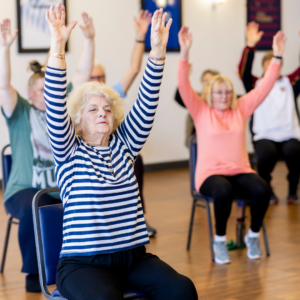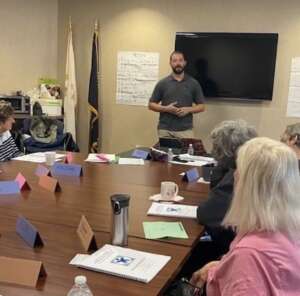February Was Heart Health Month: Tips for Safe Exercise

Exercise and a good diet are two of the greatest preventative actions that seniors can take towards overall health and mobility. For seniors looking to exercise safely at home, there are several key tips to keep in mind. First, it is crucial to start slowly and to gradually increase the intensity of the exercises to prevent injury. Low-impact activities like walking, swimming, or chair exercises are great options. It is also important to choose exercises that improve strength, balance, and flexibility to help prevent falls.
Chair Exercises:
Chair exercises are a fantastic way for seniors to stay active and maintain their physical health. These exercises are gentle, low-impact, and can be done from the comfort of a chair, making them accessible for individuals with limited mobility. Some popular chair exercises for seniors include seated leg lifts, seated marches, seated side bends, seated shoulder rolls, and seated arm curls. These exercises help improve strength, flexibility, and balance, which are crucial for overall health and reducing the risk of falls. The internet is a great resource for chair exercises tailored to seniors, and many workouts can be downloaded for free. Additionally most senior centers host chair exercise groups that you can sign up for if you’d prefer to have a knowledgeable instructor.
Walking
Walking is an excellent form of exercise for seniors for several reasons. Firstly, it is a low-impact activity that is gentle on the joints, making it an ideal choice for individuals with arthritis or other joint issues. Regular walking can help improve cardiovascular health by increasing heart rate and circulation, which in turn can lower the risk of heart disease and stroke. Additionally, walking can help maintain a healthy weight, improve balance and coordination, and even boost mood and mental well-being.
For seniors, walking also provides an opportunity to socialize and connect with others, whether it’s walking with friends, family, or joining a walking group in the community. This social aspect can help combat feelings of loneliness and isolation, which are common among older adults. Furthermore, walking outdoors exposes seniors to fresh air, sunlight, and nature, which can have a positive impact on mood and overall mental health.
Swimming
Swimming is an excellent form of exercise for seniors for several reasons. Firstly, it is a low-impact activity that is gentle on the joints, making it ideal for older individuals who may have arthritis or other joint issues. The buoyancy of the water also helps support the body, reducing the risk of injury while allowing for a wider range of motion compared to exercises on land.
Swimming is a great way to improve cardiovascular health. It can help lower blood pressure, improve circulation, and strengthen the heart and lungs. Regular swimming can also enhance muscle strength and endurance, which are crucial for maintaining balance and preventing falls in seniors. Additionally, swimming is a great way to socialize and stay connected with others, as many seniors enjoy participating in water aerobics classes or simply chatting with fellow swimmers in the pool.
Exercise To Improve Balance
Improving balance is an important aspect of maintaining physical health, especially as we age. Below are three ways in which people can improve their balance. All of these activities are best done with a friend or family member to supervise you and provide physical support if needed.
Practicing balance exercises such as standing on one foot or walking heel to toe. These exercises help to strengthen the muscles and improve coordination.
Incorporating activities such as yoga or tai chi into a workout routine. These practices focus on balance and can help to improve overall body awareness and control.
Maintaining a healthy diet and staying hydrated can also contribute to better balance by reducing the risk of dizziness or lightheadedness.
The two programs below are great resources for seniors to participate in. Our team here at Oakley Home Access often guest lectures at these programs and provides helpful tips for fall prevention and aging in place.
Rock Steady Boxing
Rock Steady Boxing is a non-contact fitness program specifically designed for individuals with Parkinson’s disease. The program incorporates elements of boxing training such as punching bags, speed bags, and focus mitts, along with traditional exercises like stretching, calisthenics, and circuit training. The focus is on improving overall physical fitness, agility, balance, hand-eye coordination, and mental sharpness.
Rock Steady Boxing has gained popularity for its ability to help individuals with Parkinson’s disease manage their symptoms and improve their quality of life. The high-intensity workouts not only help with physical strength and mobility but also provide a sense of empowerment and camaraderie among participants. The program is typically led by certified trainers who are knowledgeable about both boxing techniques and the specific needs of individuals with Parkinson’s.

A Matter Of Balance Program
The Matter of Balance program is an evidence-based falls prevention program designed to help older adults manage concerns about falls and increase physical activity. It focuses on practical strategies to reduce the fear of falling and increase activity levels in order to improve strength and balance. The program typically consists of eight two-hour sessions conducted in a small group setting, where participants engage in discussions, learn exercises to improve balance and strength, and address concerns about falls.
Participants in the Matter of Balance program also learn about fall prevention strategies, how to make their homes safer, and how to increase their overall activity levels to reduce the risk of falls. By participating in this program, older adults can feel more confident in their ability to maintain their independence and reduce the fear of falling, leading to a higher quality of life. The program has been shown to be effective in reducing the number of falls and improving confidence in participants’ ability to prevent falls.
At the end of every Matter of Balance Program, one of our occupational therapists gives a guest lecture on home evaluation and home modifications. This lecture focuses on not only the services we can provide, but also the actions clients can take on their own.
Before starting any new exercise routine, it’s advisable for seniors to consult with their healthcare provider to ensure the chosen activities are safe and appropriate for their individual needs. Staying hydrated, wearing proper footwear, and using any necessary assistive devices are also important considerations. Additionally, incorporating proper warm-up and cool-down exercises can help prevent muscle strains and injuries. By following these guidelines and listening to their bodies, seniors can enjoy the benefits of exercise in a safe and effective manner from the comfort of their own homes.
We hope that you found this month’s blog to be beneficial. If you or a loved one would like to schedule a Free Home Safety Assessment with one of our occupational therapists, please reach out to the office at 401.429.3882.
Stay active and stay safe!
